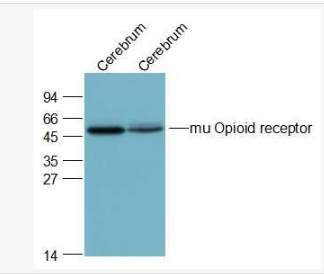| 中文名稱 | µ-型阿片受體抗體 |
| 別 名 | LMOR; MOR 1; mor; MOR1; Mu opiate receptor; mu type opioid receptor; Mu type opioid receptor MOR 1; muOR; Opioid receptor mu 1; Opioid receptor mu; OPRM; OPRM1; OPRM_HUMAN. |
| 研究領(lǐng)域 | 免疫學(xué) 神經(jīng)生物學(xué) 信號(hào)轉(zhuǎn)導(dǎo) 轉(zhuǎn)錄調(diào)節(jié)因子 激酶和磷酸酶 |
| 抗體來源 | Rabbit |
| 克隆類型 | Polyclonal |
| 交叉反應(yīng) | Mouse, Rat, (predicted: Human, Dog, Pig, Cow, Rabbit, Guinea Pig, ) |
| 產(chǎn)品應(yīng)用 | WB=1:500-2000 IHC-P=1:100-500 IHC-F=1:100-500 ICC=1:100-500 IF=1:100-500 (石蠟切片需做抗原修復(fù)) not yet tested in other applications. optimal dilutions/concentrations should be determined by the end user. |
| 分 子 量 | 45kDa |
| 細(xì)胞定位 | 細(xì)胞漿 細(xì)胞膜 |
| 性 狀 | Liquid |
| 濃 度 | 1mg/ml |
| 免 疫 原 | KLH conjugated synthetic peptide derived from human mu Opioid receptor:165-270/400 |
| 亞 型 | IgG |
| 純化方法 | affinity purified by Protein A |
| 儲(chǔ) 存 液 | 0.01M TBS(pH7.4) with 1% BSA, 0.03% Proclin300 and 50% Glycerol. |
| 保存條件 | Shipped at 4℃. Store at -20 °C for one year. Avoid repeated freeze/thaw cycles. |
| PubMed | PubMed |
| 產(chǎn)品介紹 | This gene encodes one of three opioid receptors. The mu opioid receptor is the principal target of endogenous opioid peptides and opioid analgesic agents such a s beta-endorphn and enkephalins. The NM_001008503.1:c.118A>G allele had been associated with opioid and alcohol addiction and variations in pain sensitivity but evidence is conflicting. Multiple transcript variants encoding different isoforms have been found for this gene. [provided by RefSeq, Jun 2012] Function: Receptor for endogenous opioids such as beta-endorphin and endomorphin. Agonist binding to the receptor induces coupling to an inactive GDP-bound heterotrimeric G-protein complex and subsequent exchange of GDP for GTP in the G-protein alpha subunit leading to dissociation of the G-protein complex with the free GTP-bound G-protein alpha and the G-protein beta-gamma dimer activating downstream cellular effectors. The agonist- and cell type-specific activity is predominantly coupled to pertussis toxin-sensitive G(i) and G(o) G alpha proteins, GNAI1, GNAI2, GNAI3 and GNAO1 isoforms Alpha-1 and Alpha-2, and to a lesser extend to pertussis toxin-insensitive G alpha proteins GNAZ and GNA15. They mediate an array of downstream cellular responses, including inhibition of adenylate cyclase activity and both N-type and L-type calcium channels, activation of inward rectifying potassium channels, mitogen-activated protein kinase (MAPK), phospholipase C (PLC), phosphoinositide/protein kinase (PKC), phosphoinositide 3-kinase (PI3K) and regulation of NF-kappa-B. Also couples to adenylate cyclase stimulatory G alpha proteins. The selective temporal coupling to G-proteins and subsequent signaling can be regulated by RGSZ proteins, such as RGS9, RGS17 and RGS4. Phosphorylation by members of the GPRK subfamily of Ser/Thr protein kinases and association with beta-arrestins is involved in short-term receptor desensitization. Beta-arrestins associate with the GPRK-phosphorylated receptor and uncouple it from the G-protein thus terminating signal transduction. The phosphorylated receptor is internalized through endocytosis via clathrin-coated pits which involves beta-arrestins. The activation of the ERK pathway occurs either in a G-protein-dependent or a beta-arrestin-dependent manner and is regulated by agonist-specific receptor phosphorylation. Acts as a class A G-protein coupled receptor (GPCR) which dissociates from beta-arrestin at or near the plasma membrane and undergoes rapid recycling. Receptor down-regulation pathways are varying with the agonist and occur dependent or independent of G-protein coupling. Endogenous ligands induce rapid desensitization, endocytosis and recycling. Heterooligomerization with other GPCRs can modulate agonist binding, signaling and trafficking properties. Involved in neurogenesis. Subunit: Forms homooligomers and heterooligomers with other GPCRs, such as OPRD1, OPRK1, OPRL1, NPFFR2, ADRA2A, SSTR2, CNR1 and CCR5 (probably in dimeric forms). Interacts with PPL; the interaction disrupts agonist-mediated G-protein activation. Interacts (via C-terminus) with DNAJB4 (via C-terminus). Interacts with calmodulin; the interaction inhibits the constitutive activity of OPRM1; it abolishes basal and attenuates agonist-stimulated G-protein coupling. Interacts with FLNA. Interacts with PLD2. Interacts with RANBP9 and WLS. Interacts with GPM6A. Interacts with RTP4. Interacts with SYP and GNAS. Interacts with RGS9, RGS17 and RGS20. Interacts with RGS4. Interacts with PPP1R9B and HINT1. Subcellular Location: Cell membrane; Multi-pass membrane protein. Isoform 12: Cytoplasm. Tissue Specificity: Expressed in brain. Isoform 16 and isoform 17 are detected in brain. Post-translational modifications: Phosphorylated. Differentially phosphorylated in basal and agonist-induced conditions. Agonist-mediated phosphorylation modulates receptor internalization. Phosphorylated by ADRBK1 in a agonist-dependent manner. Phosphorylation at Tyr-166 requires receptor activation, is dependent on non-receptor protein tyrosine kinase Src and results in a decrease in agonist efficacy by reducing G-protein coupling efficiency. Phosphorylated on tyrosine residues; the phosphorylation is involved in agoinist-induced G-protein-indepenedent receptor down-regulation. Phosphorylation at Ser-375 is involved in G-protein-dependent but not beta-arrestin-dependent activation of the ERK pathway. Ubiquitinated. A basal ubiquitination seems not to be related to degradation. Ubiquitination is increased upon formation of OPRM1:OPRD1 oligomers leading to proteasomal degradation; the ubiquitination is diminished by RTP4. Phosphorylation at Tyr-168 requires receptor activation, is dependent on non-receptor protein tyrosine kinase Src and results in a decrease in agonist efficacy by reducing G-protein coupling efficiency. Phosphorylated on tyrosine residues; the phosphorylation is involved in agoinist-induced G-protein-indepenedent receptor down-regulation. Phosphorylation at Ser-377 is involved in G-protein-dependent but not beta-arrestin-dependent activation of the ERK pathway (By similarity). Ubiquitinated. A basal ubiquitination seems not to be related to degradation. Ubiquitination is increased upon formation of OPRM1:OPRD1 oligomers leading to proteasomal degradation; the ubiquitination is diminished by RTP4 (By similarity). Similarity: Belongs to the G-protein coupled receptor 1 family. SWISS: P35372 Gene ID: 4988 Database links: Entrez Gene: 4988 Human Entrez Gene: 281958 Cow Entrez Gene: 18390 Mouse Entrez Gene: 25601 Rat Omim: 600018 Human SwissProt: P79350 Cow SwissProt: P35372 Human SwissProt: P42866 Mouse SwissProt: Q95247 Pig SwissProt: P33535 Rat Unigene: 2353 Human Unigene: 457998 Mouse Unigene: 10118 Rat Important Note: This product as supplied is intended for research use only, not for use in human, therapeutic or diagnostic applications. |
| 產(chǎn)品圖片 |
我要詢價(jià)
*聯(lián)系方式:
(可以是QQ、MSN、電子郵箱、電話等,您的聯(lián)系方式不會(huì)被公開)
*內(nèi)容:









